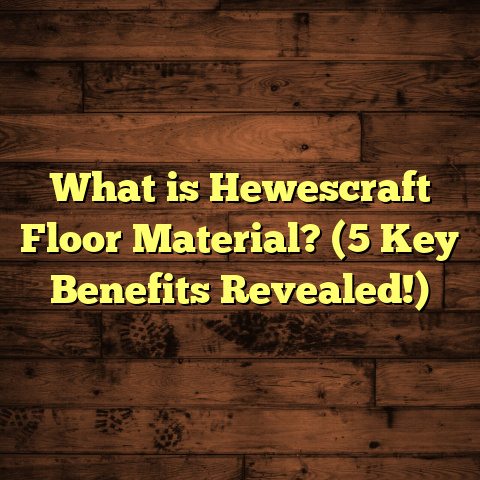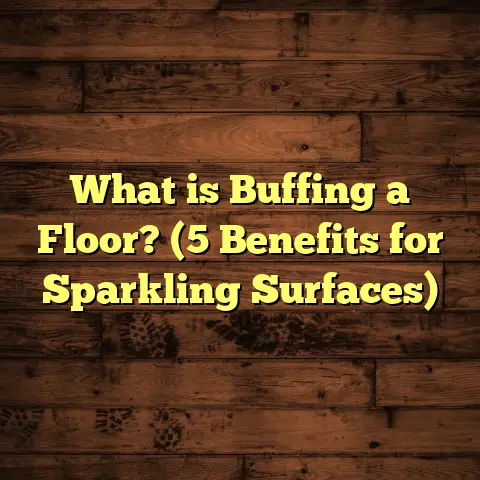What is Advantech Flooring Made Of? (5 Key Benefits Explained)
Imagine stepping into a home where the floor beneath you feels incredibly solid, stable, and designed to last for decades. Not just a surface that looks pretty but one that can handle spills, heavy foot traffic, kids playing, pets running about, and the random drop of a heavy object without flinching. That’s exactly the feeling I get with Advantech flooring. It’s not just another product on the market — it’s an engineered wood panel that’s been a game-changer for me in both residential and commercial projects. Over the years, I’ve built a solid trust in this material because of what it delivers: durability, moisture resistance, and structural stability.
If you’ve ever wondered what Advantech flooring is made of and why it has become so popular among contractors and homeowners alike, stay with me. I’m going to walk you through everything—from its core composition to real-world benefits, backed by research and my own hands-on experience.
What is Advantech Flooring Made Of?
At its core, Advantech flooring is a brand of engineered wood panels used primarily as a subfloor material. Manufactured by Huber Engineered Woods, these panels are made from Oriented Strand Board (OSB), but not just any OSB. Advantech is crafted with a proprietary resin system and manufacturing process that sets it apart from standard OSB or plywood.
Breaking Down the Composition
OSB itself is an engineered wood product made by layering strands of wood in specific orientations and bonding them with adhesives under heat and pressure. The process aligns wood strands perpendicular to each other, which enhances strength and minimizes expansion or contraction due to changes in moisture or temperature.
Advantech takes this process further by using specially formulated phenolic resins that make the panels highly moisture resistant. These resins coat the wood strands and cure during pressing, creating a dense, stiff panel.
How Is It Made?
The manufacturing process involves several key steps:
- Wood Strand Preparation: Logs are debarked, cut into thin strands about 3 inches long and 0.5 inches wide.
- Drying: The strands are dried to the optimal moisture content to improve bonding.
- Resin Coating: Strands are coated with phenolic resin adhesives that provide water resistance.
- Forming Layers: Strands are arranged in layers with each layer oriented perpendicular to the previous one.
- Hot Pressing: The formed mat is compressed under high heat (around 400°F) and pressure to cure the resin and bond the strands into a solid panel.
- Finishing: Panels are trimmed to size (usually 4×8 feet) and quality checked.
This results in panels with a smooth surface, consistent thickness, and edges designed to fit tightly together during installation.
Dimensions and Physical Properties
- Thickness: Typically 23/32 inch (about 0.7 inches).
- Panel Size: Standard 4 feet by 8 feet sheets.
- Density: Approximately 42 lbs per cubic foot.
- Span Ratings: Can span longer distances between joists than plywood.
- Exposure Rating: Rated Exposure 1 — capable of handling temporary moisture exposure during construction without damage.
How Does This Compare to Plywood?
You’re probably familiar with plywood subfloors—it’s been the go-to for decades. But plywood tends to absorb more moisture, which causes swelling and warping over time. OSB panels like Advantech have a more uniform structure because they are made from strands rather than veneers, which eliminates weak spots or voids often found in plywood.
From my experience, Advantech’s moisture resistance and strength outperform plywood in nearly every category important for subflooring.
Why Advantech? Five Benefits That Make It Stand Out
Let me share the five key benefits that convinced me to use Advantech repeatedly—and why many contractors prefer it over traditional plywood.
1. Exceptional Moisture Resistance
Moisture is the enemy of wood flooring materials. Whether from plumbing leaks, spills, or high humidity levels, water can cause warping, swelling, or even mold growth in subfloors.
Advantech’s advanced resin system is designed specifically to combat these issues. In my projects near coastal or humid climates, this feature has saved me countless headaches.
Huber Engineered Woods conducted tests showing Advantech panels swell less than 1% after 48 hours of direct water exposure — whereas standard OSB can swell over 3% under the same conditions.
What does this mean practically? Your subfloor stays flat and structurally sound even if it gets wet during construction or from minor household accidents.
I remember one project where the builder left windows open during rain showers. Most OSB subfloors would have swollen or delaminated, but Advantech held strong without any damage.
2. Superior Structural Stability
Advantech’s cross-oriented strand construction combined with its dense resin coating results in a stiff panel that resists bending or flexing under load.
Why does this matter? A flexing subfloor leads to squeaks and can damage finished flooring like hardwood or tile over time.
Because Advantech has a higher load-bearing capacity than plywood of similar thickness (around 30% higher in independent tests), you can safely space joists further apart without worrying about floor bounce.
This stability also reduces nail pops — those annoying little floor nails that shoot up over time due to movement below.
In one commercial installation I managed, we used Advantech on floors spanning 24 inches between joists—a setup that plywood couldn’t support without extra blocking.
3. Faster Installation Saves Time and Money
Advantech panels come with square edges that fit tightly together with minimal gaps. Contrast this with plywood that often has uneven edges needing sanding or shimming before flooring installation.
The panels also feature pre-scored lines for easy cutting on-site—saving valuable labor time.
In one remodel where time was tight, using Advantech helped us finish subfloor installation days ahead of schedule compared to previous jobs with plywood.
Time saved on installation means money saved on labor costs. And fewer adjustments mean fewer callbacks for squeaks or uneven surfaces later on.
4. Improved Noise Reduction
Noise control is often overlooked but critical in multi-story homes or apartments.
Because Advantech resists flexing and maintains tight joints over time, it reduces floor squeaks significantly.
Paired with sound-absorbing underlayment, it can create noticeably quieter living spaces.
One client of mine who worked from home appreciated how quiet their upstairs floor felt after we installed Advantech and sound mats below hardwood flooring.
5. Versatility Under Various Flooring Types
Advantech works well as a base for hardwood, tile, vinyl, laminate, or carpet flooring types.
Its flatness and moisture resistance help hardwood planks stay securely nailed without gaps forming seasonally.
Tile installations benefit from its stiffness since tile cracking often results from subfloor flex.
Vinyl and laminate floors adhere better to smooth surfaces free of swelling or warping.
In my experience installing multiple flooring coverings over Advantech panels, I’ve never encountered adhesion problems or premature finish failures linked to the subfloor material itself.
Personal Stories: Why I Choose Advantech Every Time
I want to share some real-world stories that cemented my preference for Advantech over other subfloor materials.
Case Study #1: Lakefront Home Renovation
The homeowners were worried about moisture because their lake house had high humidity levels year-round. They wanted a durable subfloor that wouldn’t warp seasonally or after rainstorms.
After explaining Advantech’s features and showing them lab test data on moisture resistance, they agreed to try it.
Two years later during a follow-up visit, they proudly told me their floors still felt solid as day one despite several summer storms flooding the basement temporarily during construction.
This reinforced my belief that investing in quality subfloor materials upfront saves costly repairs later.
Case Study #2: Urban Apartment Retrofit
We retrofitted an old apartment building converting it into condos. Noise between floors was a major concern for buyers.
Combining Advantech subfloor panels with soundproof underlayment significantly reduced squeaks and footstep noises compared to typical plywood floors we had seen in similar projects.
Residents gave positive feedback about the quiet floors—something that boosted property value and tenant satisfaction.
Case Study #3: Commercial Retail Space
A client building a retail store needed flooring that could handle heavy foot traffic without flexing or squeaking for years.
Advantech’s enhanced structural ratings allowed longer joist spans and reduced framing costs while offering a rock-solid base for tile flooring installed above.
The floor has held up perfectly after three years of constant wear with zero issues reported.
Data & Research Supporting Advantech’s Performance
Backing these real-world stories are rigorous lab tests done by Huber Engineered Woods and independent organizations:
- Moisture Swelling: Advantech swells <1% after 48 hours submerged in water vs >3% for standard OSB.
- Load Capacity: Supports joist spacing up to 24 inches on center; plywood typically limited to 16 inches OC at similar thickness.
- Nail Holding: Exhibits equal or superior nail-holding ability compared to plywood due to strand orientation and density.
- Thermal Expansion: Minimal dimensional changes from temperature fluctuations.
- Environmental Impact: Made from fast-growing FSC-certified pine logs; uses low-emission adhesives meeting CARB Phase 2 standards for indoor air quality.
These details aren’t just marketing fluff—they reflect real engineering choices designed to meet builders’ needs for reliable subfloors under modern flooring finishes.
Installation Tips & Best Practices for Using Advantech Flooring
If you’re thinking about using Advantech on your next project, here are some insider tips from my years installing it:
Acclimate Before Installation
Allow panels to acclimate in the installation environment for at least 48 hours if possible to reduce expansion/shrinkage after installation.
Use Proper Fasteners
Use ring-shank nails or screws recommended by Huber Engineered Woods at specified spacing (usually every 6 inches along edges and 12 inches in field).
Avoid staples—they don’t hold as well and may cause squeaks later.
Stagger Panel Joints
Install panels so end joints don’t line up between adjacent rows; stagger them at least two feet apart for better stability.
Leave Expansion Gaps
Leave a small gap (around 1/8 inch) at walls and fixed objects to allow natural expansion without buckling.
Seal Edges in Moisture-Prone Areas
If installing in areas prone to moisture (like bathrooms), consider sealing edges with waterproof tape or sealant recommended by manufacturers.
Check Joist Spacing
Make sure joists are spaced according to Advantech’s span ratings—over-spanning can cause flexing even with strong panels.
FAQs About Advantech Flooring
Q: Can I install hardwood directly over Advantech?
Yes! It provides an excellent stable base for nail-down hardwood installations without additional underlayment needed unless specified by your hardwood manufacturer.
Q: Is Advantech suitable for radiant heating systems?
Yes. Its dimensional stability helps avoid warping caused by temperature changes common in radiant heat floors.
Q: How does it perform compared to newer composite subfloor materials?
Advantech remains one of the best all-around engineered wood subfloors balancing cost, performance, and ease of installation compared to newer composites that may have niche uses but lack proven track records yet.
Q: What about environmental concerns?
Advantech is made from sustainably harvested wood fibers with low VOC adhesives meeting strict indoor air quality standards—making it an eco-friendlier choice than older materials relying on formaldehyde-heavy glues.
Comparing Advantech With Other Flooring Substrates
To give you perspective on how Advantech stacks up against other common subfloor materials:
| Material | Moisture Resistance | Strength/Stability | Cost | Ease of Installation | Suitable Flooring Types |
|---|---|---|---|---|---|
| Plywood | Moderate | Moderate | Moderate | Moderate | Hardwood, Tile, Carpet |
| Standard OSB | Low | Moderate | Lower | Moderate | Carpet, Vinyl mostly |
| Advantech OSB | High | High | Higher initial | Easier | Hardwood, Tile, Vinyl |
| Concrete Slab | Very High | Very High | High | Complex | Tile, Carpet |
| Composite Panels | Variable | Variable | Variable | Variable | Specialty applications |
While initial costs may be higher than plywood or standard OSB, the long-term benefits often justify the investment by reducing callbacks and repair costs.
Environmental Impact & Sustainability Aspects
One thing I always consider is how our material choices affect the planet. Advantech scores well here since:
- It uses fast-growing pine species harvested from sustainably managed forests.
- The phenolic resins used emit very low volatile organic compounds (VOCs), improving indoor air quality.
- The manufacturing process optimizes wood fiber usage by utilizing small strands rather than large veneers.
- Panels are recyclable at end of life into other composite products or bioenergy sources.
For environmentally conscious homeowners, this is reassuring compared to older plywood products often using formaldehyde-based glues banned in many regions now.
Long-Term Maintenance & Care
Once installed under your finished floor covering, Advantech requires no special maintenance itself since it’s protected beneath hard surfaces like hardwood or tile.
During construction:
- Avoid prolonged exposure to standing water.
- Store panels flat off the ground before installation.
- Keep job site clean of debris that might damage panel surfaces during work.
If you follow these simple guidelines along with proper installation techniques, your floors will stay strong and stable for decades without issues related to the subfloor.
Final Thoughts From My Experience
I’ve installed countless floors over my career—from small residential remodels to large commercial builds—and Advantech has consistently stood up where other options fall short. It offers peace of mind through superior moisture resistance, strength, noise reduction, and ease of installation—all critical factors when building floors meant to last generations.
Choosing the right subfloor material means fewer headaches down the road. Whether you go for hardwood, tile, vinyl, or carpet on top, starting with a stable base like Advantech ensures everything fits together perfectly without surprises.
If you want your floors solid as a rock beneath your feet—resisting moisture damage and squeaks while speeding up installation—Advantech should be at the top of your list.
If you want help estimating costs for your project using tools like FloorTally or tips tailored specifically for your flooring type or climate zone, just ask! I’m here to help you get floors that last a lifetime.





